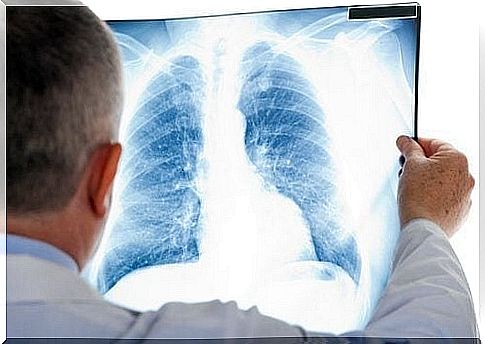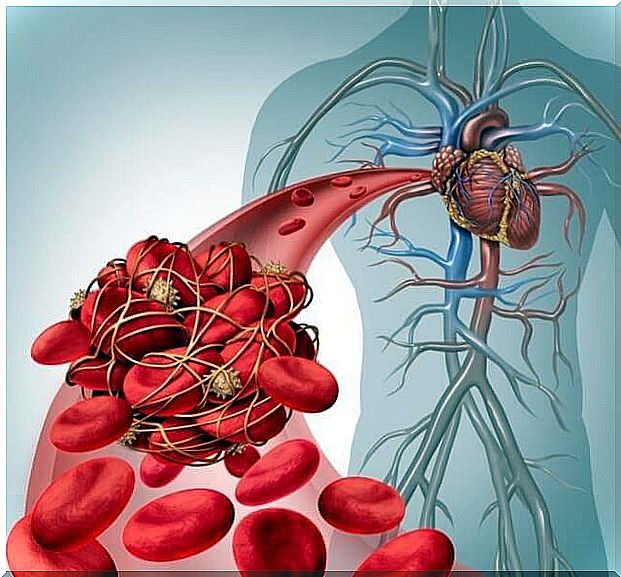Pulmonary Embolism: Symptoms And Treatment

Pulmonary embolism is a serious and quite common disorder. It is estimated that it affects one in a thousand people every year. However, it is possible that the incidence is even higher, since not all cases receive medical attention.
We talk about pulmonary embolism when a mass, usually a clot, obstructs the passage of blood to the lungs. Although embolism caused by a blood clot is more common, this condition can also originate from a lump of fat or even a sudden entry of air.
Pulmonary embolism is a dangerous condition with an estimated lethality of between 8 and 10% of total cases. Severity is determined by the caliber of the blocked artery, as well as the amount of lung tissue affected.
What is pulmonary embolism?

Pulmonary embolism is a sudden blockage of a pulmonary artery. This usually occurs when parts of a thrombus break away from a vein to migrate and become fixed within a pulmonary artery. Based on the level of severity, pulmonary embolisms are classified into two large groups.
- High-risk : hypotension or shock is present. It generates an early mortality of at least 15%.
- With normal pressure : in this case the pressure remains within normal values. It includes two subgroups.
- Low-risk: Typically treated on an outpatient basis.
- With increased risk of complications: requires hospitalization and timely treatment.
Causes
Most cases of pulmonary embolism are subject to risk or trigger factors. This means that it can be seen as a consequence of another health problem. The main risk factors are:
- Injuries to the lower limbs.
- Spinal injuries.
- Severe trauma.
- Invasive surgical interventions.
Cancer is another risk factor. Those of the lung, pancreas, and central nervous system are more likely to cause a thrombotic complication. The same happens with gastrointestinal cancers and haematological malignancies.
The hereditary factor also seems to exert some influence, although it is not decisive. Pulmonary embolisms are more common in women taking oral contraceptives. Pregnancy is also a risk factor, particularly during the third trimester and up to six weeks after delivery.
Finally, a higher incidence was found among women undergoing in vitro fertilization and postmenopausal women following hormone replacement therapy. In the latter case, the degree of risk depends on the drug used.
Symptoms

The main symptoms of pulmonary embolism are difficulty breathing and chest pain. The feeling of lack of air, or wheezing, is the most common symptom. It manifests itself as difficulty in inhaling deeply and exhaling fully and satisfactorily. She is suddenly warned.
It is also common to experience chest pain, usually sudden, oppressive and intense felt from behind the breastbone and similar to a heart attack. Pain increases when coughing or inhaling; it does not fade when changing position. The following symptoms are also common:
- Fainting or syncope.
- Dry cough or with expectoration.
- Hemoptysis or blood from the mouth when coughing. It can indicate a pulmonary infarction.
- Tachypnea : increased respiratory rate.
- Tachycardia : increased heart rate.
- Other symptoms such as pale skin, cyanosis or bluish skin color, dizziness, fever, sweating and confusion.
Pulmonary embolism diagnosis and treatment
Pulmonary embolism is diagnosed by combined evaluation of clinical suspicion, imaging and D-dimer blood test. Suspicion is provided by symptoms; chest x-ray, electrocardiogram and arterial blood gas analysis confirm the diagnosis.
The basic treatment consists in the administration of anticoagulants, first parenterally (intravenously, intramuscularly or subcutaneously) and then orally.
The prognosis is good if the embolism is detected and treated in time. In 3.8% of cases, however, the embolisms become chronic. For several years, the rate of deaths during hospitalization due to pulmonary embolism has decreased significantly.









